BEAT THE

VOL 25 / ISSUE 31 / 10 AUGUST 2023 / £4.49
Invest in companies and funds fighting climate change







12
GREAT IDEAS
15 EDITOR’S VIEW
• Why forecasters are dumping US recession predictions en masse
• What do Wilko’s woes mean for retail property shares?
• Investors are proving to be wary about new US float SharkNinja - here’s why
• Marks & Spencer share price at highest level since January 2022
• Ukrainian miner Ferrexpo down 82% in two years on the stock market

New: BlackRock Throgmorton Trust / Convatec Updates: Apple
Small caps are really unloved but there are three big reasons this antipathy is misplaced
16 FEATURE Magnificent Seven: five things we learned from their latest earnings
20 FEATURE Beat the heat: How to invest in companies and funds fighting climate change

25 FEATURE How to analyse Unilever in five easy steps

30 RUSS MOULD
The US economy has kept powering ahead but can it continue?
32 FEATURE How packaging companies are positioned for the shift away from plastic
36 PERSONAL FINANCE
What are the tax implications of having a side hustle like selling on Ebay or Etsy? 39 ASK TOM


The lifetime allowance is being abolished but what if a future government reintroduces it?

10 August 2023 | SHARES | 03 Contents 20 39 09 25 06
NEWS
42 INDEX Shares, funds, ETFs and investment trusts in this issue 13 36
inHowtoanalyseUnilever fiveeasysteps
FTSE100consumergoodsgiant
Howtoinvestincompaniesandfunds fightingclimatechange

Three important things in this week’s magazine 1 2 3
HAsiaugeswathesofEurope,NorthAmerica, andAfricahaveenduredboiling ofconditionsthissummer,withthemajority scientistspinningtheblameforthe planet’sexceptionalheatandrain,aswellas onwildfiresincountriessuchasGreeceandCanada, Datahumanactivity. ChangefromtheEU-fundedCopernicusClimate Serviceshowedthatthefirstthreeweeks ofJulywerethewarmestthree-weekperiodon record.Andthereismoretocome,withtheWorld MeteorologicalOrganizationpredictinga98% willlikelihoodthatatleastoneofthenextfiveyears ‘Thebethewarmesteverrecorded.extremeweather–anincreasinglyfrequentoccurrenceinourwarmingclimate–ishaving amajorimpactonhumanhealth,ecosystems,
Beat the heat
ByJamesCrux FundsandInvestmentTrustsEditor economies,agriculture,energyandwatersupplies,’ ‘ThiswarnstheWMO’ssecretarygeneralPetteriTaalas. greenhouseunderlinestheincreasingurgencyofcutting gasemissionsasquicklyandasdeeply aspossible.’ IN HOT WATER Hotoceansareamplifyingweather-driven catastrophes.AccordingtoERA5data,dailysea surfacetemperaturesaveragedovertheglobal extrapolaroceans(60°S-60°N)havestayedat recordvaluesforthetimeofyearsinceApril2023. ScientistshaveidentifiedanArgentina-sizedchunk missingfromtheseaiceontheAntarcticOcean, thiswhichreachedbyfaritslowestlevelforanyJune year.

Discover funds and stocks which are at the forefront of the fight against climate change

Analysing Unilever

mini-series aimedatarmingreaderswithaneasy-tomostusefivestepframeworkwhichcanbeappliedto Hopefullypopulartypesofcompany.thestructurewe’veprovidedwill you,allowyoutoquicklyassessifastocklooksrightfor withbuilt-inrest-stopsateachstagewhere onyoucandecidetohopoffforadeeperdiveorcarry learning. ANALYSINGUNILEVER Inthisinstalment,wearegoingtolookatUnilever (ULVR),oneoftheworld’slargestconsumer goodscompaniesandonewhosesharesare widelyowned,todecidewhetheritmakesagood investmenttoday. withHopefully,youwillcomeawayfromthisfeature consumeradeeperunderstandingofwhatdrivesthe giant’sperformanceandafairchanceof sizingupwhetherthatwillcontinueinthefuture. STEP 1 ANALYSINGSALESGROWTH overLet’sstartbylookingatrevenuegrowth thelastdecade.Thefirstthingto itnoteaboutUnileverisitisn’tasinglebusiness, ervingisacollectionoffiveseparateunitseachs personaldifferentconsumermarkets:homecare, care,beautyandwellbeing,nutritionandicecream. haveThetableoverleafshowshowUnilever’ssales grownoverthelastdecade... changedAsecondpointtomakeisthatthegrouphas alotoverthelastdecadeasbusinesseshavebeenboughtandsold,andtherateof caninflation–whichdictateshowmuchthefirm decade,raiseprices–hasalsochangedoverthelast Pricingespeciallyinthelasttwoyears.poweriscrucialforacompanylike Unileverbecausesalesgrowthfactorsinthe volumeofsalesforeachproductlineandthe averagesellingprice. itsAsaruleofthumb,themoreacompanyraises pricesthebiggerthenegativeeffectonvolumes withascustomerslookforalternatives–onlyfirms strongbrandscanraisepriceswithouthurtingunitsales.AnotherimportantfactorforUnileveristhe

Five steps to understand the investment case behind the consumer goods giant including margins, cash flow and valuation


Visit our website for more articles

Did you know that we publish daily news stories on our website as bonus content? These articles do not appear in the magazine so make sure you keep abreast of market activities by visiting our website on a regular basis.
Over the past week we’ve written a variety of news stories online that do not appear in this magazine, including:
Feature:TheMagnificentSeven
MagnificentSeven:fivethingswe learnedfromtheirlatestearnings
Takingstockafteranrampantyearofsharepricegains fromthelikesofNvidia,Tesla,AmazonandApple
Basigtechstockshavebeenflyingthisyear groundinvestorsscrambletogetinonthe technologicalfloorofwhatcouldbethenext revolution.Inthefirsthalf gainsoftheyeartheNasdaqCompositechalked-up33% astech’s‘MagnificentSeven’stockssoared. haveBoththeNasdaqandS&Pindices soaredthisyear
100
The Magnificent Seven
market’sAnalystsputthesurgedowntothreefactors:the ‘yearofefficiency’focuswithoperating costsreeledintobolsterprofitability,agrowing cycleconfidencethattheFederalReserve’stightening wasnearingitsendgame,andtheemergence thatofgenerativeAI(artificialintelligence)applications Therepromiseaneweraofgrowthandprosperity. wasafearthatearningsandrevenue latestgrowthwerethemissingingredientsbutafterthe optimismquarterlyearningsreports,therearesignsof heretoo.Bigtechsharepriceshave,byandlarge,continuedtorally.Here’swhatShares gleanedfromlatestbigtechearnings. AIISMEASURINGUPTOTHEHYPE TwoAIheavyweights,Microsoft(MSFT:NASDAQ) andGoogle-parentAlphabet(GOOG:NASDAQ) publishedtheirfirstearningsreportssincesinking billionsofdollarsintoAIprojects.Carryinghuge techimplicationsbeyondAI–cloudcomputingandthe sectorbroadly–investorshadtheireyesfixed theonthefiguresandforwardearningsguidanceand verdictwasmixedforthetwostocks.
Find out how the leading US tech firms performed in the second quarter earnings season
Beyond Meat shares plunge in after hours trading as cost-of-living crisis bites

04 | SHARES | 10 August 2023 Contents
Feature: Unilever 10August2023 | SHARES 25
ollowingourlookatMicrosoft
Shares
Unilever(p) 20142016201820202022 2,000 2,500 3,000 3,500 4,000 4,500 5,000 Chart:Sharesmagazine•Source:Refinitiv
theWeweighuptheinvestmentcasefor
F
(MSFT:NASDAQ),thisisthesecondinstalmentinthe
16
10August2023
SHARES
Rebased
Oct 2022 Jan 2023 AprJul 90 100 110 NASDAQCOMPOSITE S&P500
Chart:Sharesmagazine•Source:Refinitiv
SHARES 10August2023 BEAT
20
THE
Summer travel boom continues as airlines shrug off Greek wildfires disaster
WPP shares fall 7% as the advertising giant cuts annual revenue forecast
Discover why these three shares are making new 12-month highs
Capital at risk.
That’s the sweet sound of taking control of your investments with AJ Bell.



Why forecasters are dumping US recession predictions en masse
Increasing numbers of forecasters are now predicting that the US economy will not suffer a recession this year, even in the face of US debt being downgraded.
Fitch Ratings downgraded its US debt rating on 1 August from the highest AAA rating to AA+, citing ‘a steady deterioration in standards of governance’. The downgrade comes after lawmakers negotiated up until the last minute on a debt ceiling deal earlier this year, risking the nation’s first default on government bonds.
Yet economists at several leading investment banks are now predicting a ‘no landing, no recession’ scenario in the US, including Goldman Sachs, Bank of America, and JPMorgan Chase.
This is instead of the so-called soft landing of a mild downturn and moderating inflation.
JPMorgan Chase economists scrapped their call for a recession in the US in early August, joining a growing number of forecasters who now expect the economy to avert the downturn that was once viewed as inevitable. The bank, which had previously said it expected a recession to begin in 2023, now sees continued expansion this year and ‘modest, sub-par growth’ in 2024 as the most likely scenario.
Michael Feroli, JPMorgan’s chief US economist, flagged the rising possibility of ‘healthy noninflationary growth’ thanks to potential productivity gains from artificial intelligence and a pickup in employment data.
‘The probability of a US recession in the coming year has declined, as the risk of a disruptive debtceiling fight has disappeared and stress in the
banking sector appears to be only a modest drag on the economy,’ Goldman Sachs economists said.
The investment bank’s forecasters say there’s a 25% chance of recession in the next 12 months, down from their earlier projection of 35% shortly after the failure of Silicon Valley Bank in March.
Economists and analysts have been predicting a downturn in the US economy for a more than a year, mostly due to high inflation and the steps policymakers have been taking to curb it. Officially, a downturn is defined as a decline in gross domestic product for two consecutive quarters.
Yet economic data continues to be supportive. The unemployment rate is still at ‘near all-time lows,’ Bank of America noted. The most recent (4 August) jobs report showed the unemployment rate was 3.5% based on new July data, ‘just above the lowest level since late 1969’. This has also led to speculation the Federal Reserve will hold rates at a higher level for longer.
US payroll growth has proved
Chart: Shares magazine•Source: US Bureau of Labor Statistics
Unemployment and other factors – growth in economic activity, wage and price pressures in the ‘right direction’ – prompted Bank of America to reassess its previous calls for a mild recession in 2024. The investment bank is weighting those baseline expectations for a soft landing at 45% to 50%, although it accepts that other outcomes are still possible. [SF]
News 06 | SHARES | 10 August 2023
A ‘no landing, no recession’ scenario is become more likely, according to leading investment banks
robust Jul ’22 Aug ’22 Sep ’22 Oct ’22 Nov ’22 Dec ’22 Jan ’23 Feb ’23 Mar ’23 Apr ’23 May ’23 Jun ’23 Jul ’23 568,000 352,000 350,000 324,000 290,000 239,000 472,000 248,000 217,000 294,000 339,000 185,000 187,000
What do Wilko’s woes mean for retail property shares?
In news that surprised everyone from shoppers to investors, general retailer Wilko announced in early August it had filed a ‘notice of intention’ to appoint administrators due to mounting cash pressures on the business.
The firm, whose stores are a feature on most UK high streets, is reportedly losing market share to rivals such as B&M European Value (BME), Home Bargains and The Range.
Compounding its problems, the retailer has struggled to fill its shelves this year after suppliers stepped back due to the withdrawal of credit insurance in late 2022.
According to filings, Wilko made a loss of nearly £36 million in its last financial year, more than it made in profits in the previous four years.
As we have flagged in the past, cash is key and companies which fail to convert enough of their sales into cash are always at risk of falling into a ‘liquidity trap’.
Wilko is reported to be trying to raise up to £70 million in emergency financing on one hand, while working with property firm CBRE to file a CVA (company voluntary arrangement) to reduce its store rents on the other.
CVAs were a big feature of the retail sector several years ago with companies like Arcadia
and BHS filing for protection from creditors, and according to Statista in 2020 property assets under CVA at big shopping centres like Lakeside were as high as 28%.
Trade journal Retail Gazette reported Wilko could look to suspend rent payments to some landlords for up to three years which would be a big blow to the companies affected.
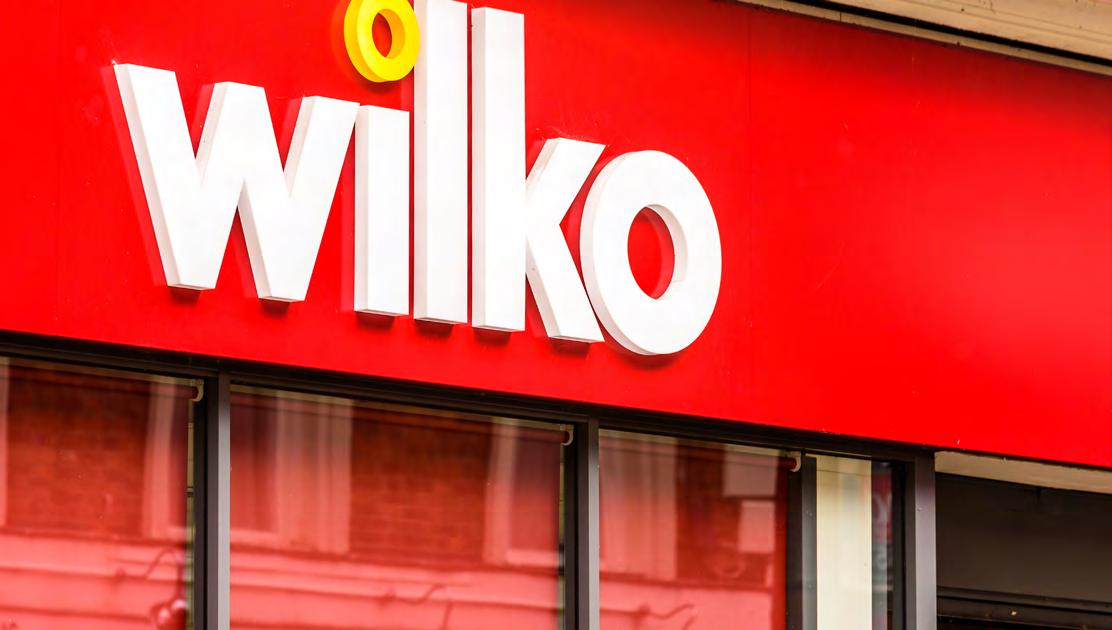
AEW UK REIT (AEWU) has direct exposure to Wilko through its Union Street unit in Bristol, which accounted for 2.6% of the total passing rental income portfolio as of 31 March this year.
While 2.6% isn’t a huge amount, AEW’s dividend was only 89% covered by income in the last quarter of 2022, with the balance coming from asset sales, so progress towards the firm’s target of 100% dividend cover is likely to be delayed, which could force the board to err on the side of caution and reduce the payout.
There is a feeling that if a big firm like Wilko can fall into financial trouble, more retailers are likely to follow, and subsequently we heard the news that Clintons was considering closing a fifth of its stores in order to stem losses.
Hopefully both firms will find the support they need, but there is bound to be a reduction in store footprints with, we suspect, less emphasis on the high street and more on retail parks. [IC]
News 10 August 2023 | SHARES | 07
Investors need to look at their direct and indirect exposure to brewing difficulties in the sector
Investors are proving to be wary about new US float SharkNinja – here’s why
Spun-out from Hong Kong’s JS Global Lifestyle (1691:HKG), household appliance innovator SharkNinja (SN:NYSE) is an interesting addition to the public markets and the shares surged on their New York Stock Exchange debut (31 July) in an early feeding frenzy.

But SharkNinja’s shares then sank below the initial public offering (IPO) price amid concerns over the company’s significant China exposure at a time of heightened geopolitical tensions between the Beijing and the US.
Boston-headquartered SharkNinja is the company behind two billion-dollar brands, Shark and Ninja. It designs and manufactures household appliances ranging from smart vacuum cleaners and air fryers to electric grills, ice cream makers, blenders and hairdryers and is growing its robot vacuum market share.
By bringing disruptive products to a massive, fragmented market and entering new product categories, SharkNinja has successfully driven significant growth and market share gains. Its products are sold through key retailers, among them Walmart (WMT:NYSE), Amazon (AMZN:NASDAQ), Argos and Currys (CURY), and distributors around the world.
SharkNinja’s sales rose from $250 million in 2008 to a bumper $3.7 billion in 2022, an impressive compound annual growth rate of 20%. And in an interview with business channel CNBC on IPO day, CEO Mark Barrocas described his charge as a ‘consumer-solving engine’, insisting ‘we solve problems that others can’t’.
Listed at just over $30 per share, SharkNinja was propelled 40% higher in debut deals but the shares then sank below the issue price to close the week at $26.90 on 4 August as excitement waned. The shares are trading at $30.10 at the time of writing, giving SharkNinja a market value just shy of $4.2 billion.
While the bulk of SharkNinja’s sales are derived from North America, the market newcomer has significant exposure to China. This brings with it risks due to geopolitical tensions and the complexities of the trade relationship between the world’s two biggest economies.
Since 2020, SharkNinja has paid over $3.3 billion to JS Global subsidiaries for merchandise and goods made in China in the main, which it sells to American consumers, and continues to rely on JS Global for supply chain services. Investors are also concerned about the risk SharkNinja’s tariff exemption, applicable to certain goods sent from China to US consumers, may not necessarily be extended to SharkNinja again, creating what the company warns would be ‘a substantial increase in costs’.
And in March, the International Trade Commission ruled in favour of iRobot, the Roomba vacuum cleaner maker Amazon has agreed to acquire, after it alleged SharkNinja had infringed on one of its patents. [JC]
News 08 | SHARES | 10 August 2023
SharkNinja ($) 31 Jul 01 Aug 03 05 07 30 35 40 Chart: Shares magazine•Source: Refinitiv
The company behind the billion-dollar Shark and Ninja brands has just listed across the Atlantic
Marks & Spencer share price at highest level since January 2022
Investors have been bidding up the stock since last October
Investors are finally buying into the story that Marks & Spencer (MKS) is fit for the modern world. Its shares have more than doubled in price since last October and now trade at their highest level since January 2022.
Chairman Archie Norman wrote in this year’s annual report: ‘Of all the turnarounds I have been part of, this has been the slowest and most intractable; reflecting the deep-rooted nature of our problems and culture at the “old M&S”, but we are
now at last seeing the reshaping of M&S take hold with new energetic leadership, new strong trading results and the prospect of a return to dividends.’

The food business already had a strong position, now it has even broader appeal after the retailer added more value lines. The clothing arm has been given a new look, with more appealing designs
Ukrainian miner Ferrexpo down 82% in two years on the stock market

and less formalwear. It’s helped that consumer tastes have shifted – the fast-fashion trend has faded and shoppers now want better quality items and they’re finding them in Marks & Spencer.
A wet July presents a short-term risk to earnings although we note that Next (NXT) seems to have got through the month without any major problems. The next scheduled update is half-year results on 8 November. [DC]
The
iron ore producer is still feeling the effects of Russia’s invasion of its home country
Shares in Ukrainian iron ore producer Ferrexpo (FXPO) have fallen 82% from their July 2021 peak and green shoots in its half-year results on 2 August weren’t enough to stop the decline in its valuation.
The miner’s shares were already falling before Russia’s invasion of Ukraine, but life has certainly got worse for the company since the war began.
Production has been hit, overheads have gone
up and there have been challenges transporting its products as Ferrexpo’s principal loading port, the Port of Pivdennyi, remains disrupted as the conflict affects trade routes in the Black Sea, with alternative sources weighing on costs. However, when comparing the first-half 2023 period to the previous
six months, production and average selling prices have gone up.
‘Despite profits being lower and capex higher than we had expected, Ferrexpo remains in remarkably good financial shape,’ argues Liberum analyst Ben Davis. ‘The net cash position improved to $131 million, providing a comfortable buffer against any production/sales disruptions or higher energy prices.’ [DC]
News 10 August 2023 | SHARES | 09
Ferrexpo (p) 2022 2023 0 100 200 300 400 Chart: Shares magazine•Source: Refinitiv Marks & Spencer (p) Oct 2022 Jan 2023 AprJul 50 100 150 200 250 Chart: Shares magazine•Source: Refinitiv
DOWN
HIGHER Moving
in the dumps
UK UPDATES OVER THE NEXT 7 DAYS
FULL-YEAR
Insurance giant Aviva set to deliver on its growth targets
New accounting rules mean earnings will look a lot different this year
In its first-quarter trading update in May, composite insurance giant Aviva (AV.) reported strong growth across its retirement, health and general insurance lines.

Retirement earnings were boosted by positive trends in the bulk purchase annuity market following a string of interest rate rises this year, and the firm hinted its pipeline for the second year looked strong.
Meanwhile, health has benefited from increased demand from individuals and companies due to the well-publicised travails of the NHS and general insurance has seen rising premiums across the board.
accounting standard which, while it doesn’t make a difference to the company’s ability to pay a dividend, from what we can see does mean the estimates look a lot different to consensus.
For the first half, the group expects to report an operating profit of roughly £700 million, while for the full year it sees profits rising between 5% and 7% to £1.4 billion to £1.45 billion, which is around a third lower than the market is forecasting according to analysts at Jefferies, so shareholders need to bear this in mind when digesting the results which are due on 16 August. [IC]
16 August: Aviva, Balfour Beatty, Essentra, Marshalls
In July, however, the firm restated its 2022 profits and published new forecasts for its half-year and fullyear earnings under the IFRS 17

the market expects of Aviva
News: Week Ahead 10 | SHARES | 10 August 2023
RESULTS
14 August: Darktrace
HALF-YEAR RESULTS
17 August: Rank, ITM Power
11 August: Beazley
14 August: Centralnic
15 August: Georgia Capital, Just Group, Convatec, Kenmare Resources
17 August: Intelligent Ultrasound, Empiric Student Property, Bank of Georgia
Forecast for 2023 47.9 24.0 Forecast for 2024 54.6 24.7 EPS (p) Revenue (£bn) Table: Shares magazine Source: Stockopedia Aviva Oct 2022 Jan 2023 AprJul 380 400 420 440 460 Chart: Shares magazine•Source: Refinitiv
What
Can trading down trends drive upgrades for T.K. Maxx owner TJX?

Investors will be looking for confirmation of continued likefor-like sales growth, progress in reducing inventories and raised guidance when discount apparel-tohome fashions seller TJX Companies (TJX:NYSE) delivers second quarter results (16 August). The consumer spending squeeze from high inflation should supporting market share gains.
Trading as T.J. Maxx, Marshalls and HomeGoods in the US and T.K. Maxx and HomeSense in Europe, the ‘off-price’ retailer has repeatedly proven its resilience in tougher economic times as cash-strapped consumers trade down and increased its 2024 earnings per share guidance alongside forecast-beating first quarter earnings (17 May).
These showed a 3% increase in first quarter like-for-like store sales, at the high end of company guidance and driven by an increase
in customer traffic and a 5% likefor-like sales increase at Marmaxx, the group’s largest division which combines the T.J. Maxx, Marshalls and Sierra store chains.
CEO Ernie Herrman said the strength and flexibility of TJX’s off-price business model and wide demographic reach provide ‘great confidence in our ability to continue to succeed in today’s retail environment.
‘Every day, our global organisation is focused on bringing customers around the world excellent values on great fashions and great brands and an exciting, treasure-hunt shopping experience. We are pleased that the second quarter is off to a good start and we are seeing phenomenal off-price buying opportunities in the marketplace.’ [JC]
US UPDATES OVER THE NEXT 7 DAYS
QUARTERLY RESULTS
15 August: Home Depot, Agilent Technologies, Cardinal Health, Jack Henry & Associates

16 August: Cisco, TJX, Synopsys, Target, Bath & Body Works
17 August: Walmart, Applied Materials, Ross Stores, Keysight Technologies, Tapestry
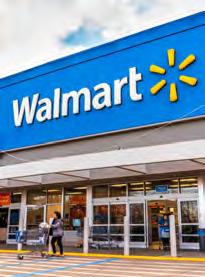
News: Week Ahead 10 August 2023 | SHARES | 11
What
Q2 forecast $0.7512.4 EPS ($) Revenue ($bn) Table: Shares magazine•Source: Yahoo Finance TJX Oct 2022 Jan 2023 AprJul 65 70 75 80 85 Chart: Shares magazine•Source: Refinitiv
Down-trading trends and shoppers’ love of a treasure hunt are supporting market share gains
the market expects of TJX
Buy BlackRock Throgmorton for quality growth at a bargain price
return of 158.5% is comfortably ahead of the 95.6% from the AIC’s UK Smaller Companies sector and the 48.5% total return from the Morningstar UK Small Cap index.
Investors seeking to position portfolios for a rally in small and mid cap stocks should buy BlackRock Throgmorton Trust (THRG), a fund with a strong long-run performance record trading at a 7.2% discount to net asset value (NAV), wider than the 4.7% 12-month average.
The sell-off in quality growth stocks caused by rising interest rates has been a headwind for the portfolio, but Shares sees manager Dan Whitestone’s stock picking skills, ongoing positive performance and a peak in interest rates offering combined catalysts for a narrowing of the discount at BlackRock Throgmorton, which should benefit strongly once UK mid and small caps swing back into favour.
Despite headwinds to performance from sticky UK inflation and higher rates, Whitestone has remained unwavering in his commitment to differentiated growth companies and industry disruptors that are winning market share and he continues to see good value within the UK small cap universe. Uniquely for a smaller companies trust, BlackRock Throgmorton allows Whitestone to short weak companies, such as those disrupted by industry change.
Admittedly, BlackRock Throgmorton has seen a relatively quiet period recently with NAV up a mere 0.1% in the six months to May 2023. Nevertheless, performance was still ahead of the Numis Smaller Companies plus AIM (excluding Investment Companies) benchmark’s 2.4% decline and the FTSE 250 trust’s 10-year share price total
Importantly, earnings remain strong for many of the companies within Whitestone’s portfolio of ‘best of breed’ companies with the strong balance sheets and financial resilience to weather the storm, with industrials and consumer discretionary the two biggest sector weightings at last count. For instance, fantasy miniatures maker Games Workshop (GAW) has continued to grow sales and profits ahead of expectations, homewares leader Dunelm (DNLM) is gaining market share while science kit maker Oxford Instruments (OXIG) has maintained its record of beating expectations and raising guidance.
Other holdings including Breedon (BREE), Grafton (GFTU), Gamma Communications (GAMA:AIM), Ergomed (ERGO:AIM) and Morgan Sindall (MGNS) have continued to de-rate despite upgrades, allowing Whitestone to top up on weakness.
New portfolio additions range from Intermediate Capital (ICP) and SIG (SHI) to Future (FUTR) and Crest Nicholson (CRST). One point worth noting is BlackRock Throgmorton’s fee structure, with ongoing charges of 0.54% including a performance fee in addition to what is a low 0.35% base fee, which adds a little complexity to charges. However, whichever way you stack them up, the costs are competitive with similar funds. [JC]
Great Ideas: Investments to make today 12 | SHARES | 10 August 2023
This fund’s focus on ‘best of breed’ growth stocks has delivered outperformance over the long term
BlackRock Throgmorton (p) 20192020202120222023 200 400 600 800 1,000 Chart: Shares magazine•Source: Refinitiv Blackrock Throgmorton (THRG) Price: 574p Market cap: £570.8 million
benefit
A
ConvaTec (CTEC)
Snap up medical products outfit ConvaTec (CTEC) as a multi-year turnaround gains traction. Recent evidence for this came as the company raised full year guidance for the second time this year (2 August), delivering accelerated revenue growth in the six-month period to 30 June.
After a downward trend in the share price, the positive news has helped to turn the tide and we think this could be the precursor to further gains. CEO Karim Bitar, who was previously chief executive of animal genetics firm Genus (GNS), took over the reins at ConvaTec in 2019.
Bitar says: ‘We have now pivoted to sustainable revenue growth and are expanding our operating margin. We are increasingly confident of delivering sustainable future growth and an operating margin in the mid-20s.’
ConvaTec develops and sells products used
to treat chronic conditions encompassing areas around wound care, ostomy care and continence. The company should be a beneficiary of structural growth in its end markets linked to ageing demographics but execution has been patchy in the past.

Under its current management this is beginning to change and there has been an effort to centralise its internal IT, finance and legal functions which should help improve profitability.
Having already upped organic revenue guidance in May 2023 to between 5% and 6.5% from 4.5% to 6% the company raised the bar again to a range of 6% to 7.5% and increased adjusted operating margin projections to ‘at least’ 20.5% from 19.7% previously.
The company increased the first-half dividend by 3% to $1.76 per share and ended the period with net debt of $1.29 billion, equivalent to 2.5 times earnings before tax, interest, depreciation, and amortisation, a measure of financial leverage. [MG]
Great Ideas: Investments to make today 10 August 2023 | SHARES | 13 ConvaTec (p) 20192020202120222023 100 150 200 250 Chart: Shares magazine•Source: Refinitiv
turnaround of the wound care specialist is gaining traction
Price: 226.6p Market cap: £4.6 billion ConvaTec profile Advanced Wound Care $7bn2$621m Ostomy Care $3bn3$522m Continence Care $2bn1*$546m Infusion Care $1.6bn1$384m Market Size Position 2022 sales Table: Shares magazine • Source: Convatec. * Leading US retailer in catheters ConvaTec profile Advanced Wound Care $7bn2$621m Ostomy Care $3bn3$522m Continence Care $2bn1*$546m Infusion Care $1.6bn1$384m Market Size Position 2022 sales Table: Shares magazine • Source: Convatec. * Leading US retailer in catheters
ConvaTec has got its act together, is going for growth and its shares should
Shares thinks it is time to take profit on Apple
Stock has roared higher far faster than we predicted and a few investment niggles lie ahead
Apple

(AAPL:NASDAQ) $178.85
Gain to date: 35%
Pitching Apple (AAPL:NASDAQ) as one of our best picks for 2023 was based on a fairly simple investment premise – shares in a fantastic company had fallen too far after limping along for the best part of a year, and that had left them attractively priced versus prospects for recovery.

When push came to shove, that anticipated bounce-back was faster and went further than we expected. To have a paper profit of 35% by early August means Apple can only be considered a big win for investors that followed our call to buy the stock back in December 2022.
WHAT HAS HAPPENED SINCE WE SAID TO BUY?
The tech giants have all seen a rampant recovery in 2023, partly thanks to AI (artificial intelligence) optimism but also because the market’s ‘year of efficiency’ focus with operating costs reeled in to bolster profitability, plus growing confidence that the Federal Reserve’s tightening interest rate cycle was nearing its end with the inflation monster seemingly tamed.
Yet we cannot hide from the fact that the next few months could be a touch tougher for Apple. We won’t repeat ourselves – we’ve looked at
latest quarterly results from it and other big tech companies in a separate feature in this issue of Shares, but Apple commentary came across a little shy on confidence when it came to hardware sales.
WHAT SHOULD INVESTORS DO NOW?
The 2024 price to earnings ratio has inflated beyond 27 with analyst consensus anticipating less than 8.5% earnings growth.
Let us be clear – Apple remains a fantastic core investment opportunity long-term, with Services revenue and subscriptions very encouraging. There are other opportunities, such as personal banking, where Apple has gone from nought to $10 billion of savings in next to no time.
But taking some of that 35% profit off the table looks sensible right now, even if investors with a longer investment timeframe want to leave a rump stake in Apple. Think of it this way, you could sell two-thirds of your stake, covering your initial outlay, and giving you an effective free ride with the rest. [SF]
Great Ideas Updates 14 | SHARES | 10 August 2023
Apple ($) Oct 2022 Jan 2023 AprJul 120 140 160 180 200 Chart:
TOP STOCKS FOR 2023
Shares magazine•Source: Refinitiv
Small caps are really unloved but there are three big reasons this antipathy is misplaced
Everyone hates small and mid-cap stocks right now. Their performance has badly lagged those of their larger counterparts in recent months.
Seen as more vulnerable to the vagaries of the economy and without the scale and financial strength to withstand higher borrowing costs, investors have been abandoning them in their droves. The chart shows how the MSCI World Small Cap index has been lagging the broader MSCI World index over the last six months.
The same pattern has been repeated domestically with the FTSE 250 and FTSE Small Cap trailing behind the large cap FTSE 100.
This exodus from smaller companies and the apparent reasoning behind it ignores three important points. One, not all of them are created equal. Some have perfectly respectable balance sheets and generate healthy amounts of cash flow. Second, because they are smaller, a decent number of businesses will still be able to grow against an uncertain economic backdrop by taking market share. Finally, because they have been so unloved, valuations are looking attractive.
Investment bank Berenberg sums up the valuation gap between larger and smaller firms: ‘On a 12-month forward PE basis, the S&P 600 small-cap relative to the S&P 500 has only been cheaper 8% of the time in the last 30 years. Similarly, the STOXX 200 small-cap and midcap indices relative to large-cap have only been cheaper 3% and 2% of the time in the last 20 years. In the UK, the FTSE 250 trades at a 30-year median dividend yield high relative to the FTSE 100 – UK mid-caps have never been cheaper relative to large-caps on this basis.’
Naturally, there are risks with small caps. The
chance of outright default is undoubtedly greater, the ability to buy and sell shares freely and without a large spread between your purchase and sale price can be constrained and it can be harder to find out information about them.
This presents a compelling case for investing in small caps through funds and relying on the expertise of a professional stock picker. They can uncover the underappreciated gems which occupy the small cap universe. We highlight just such a vehicle, investment trust BlackRock Throgmorton (THRG), in our Great Ideas section this week.

That is not to say there is anything to stop you from investing in smaller companies yourself as part of a broader investment portfolio. Some people like to make these ‘satellite’ investments which can be added on top of a more stodgy and solid portfolio of core holdings.
It’s important to do your research though. Read the annual report, check the balance sheet. If the business is consumer facing even sample its products or services yourself or see how its offering is rated online.
Shares (and others) hold investor evenings and webinars where you get the chance to hear from and quiz senior executives from small and mid-cap firms. You can find details of upcoming events of this nature here.
Editor’s View: Tom Sieber
Feb 2023 Mar Apr May Jun Jul Aug 90 95 100 105 MSCI World MSCI World Small Cap Rebased to 100 Chart: Shares magazine • Source: Refinitv 10 August 2023 | SHARES | 15
Not every smaller company is created equal and valuations are looking cheap relative to larger names
Magnificent Seven: five things we learned from their latest earnings

Taking stock after an rampant year of share price gains from the likes of Nvidia, Tesla, Amazon and Apple
Big tech stocks have been flying this year as investors scramble to get in on the ground floor of what could be the next technological revolution. In the first half of the year the Nasdaq Composite chalked-up 33% gains as tech’s ‘Magnificent Seven’ stocks soared.
Analysts put the surge down to three factors: the market’s ‘year of efficiency’ focus with operating costs reeled in to bolster profitability, a growing confidence that the Federal Reserve’s tightening cycle was nearing its endgame, and the emergence of generative AI (artificial intelligence) applications that promise a new era of growth and prosperity. There was a fear that earnings and revenue growth were the missing ingredients but after the latest quarterly earnings reports, there are signs of optimism here too. Big tech share prices have, by and large, continued to rally. Here’s what Shares gleaned from latest big tech earnings.
AI IS MEASURING UP TO THE HYPE
Two AI heavyweights, Microsoft (MSFT:NASDAQ) and Google-parent Alphabet (GOOG:NASDAQ), published their first earnings reports since sinking billions of dollars into AI projects. Carrying huge implications beyond AI – cloud computing and the tech sector broadly – investors had their eyes fixed on the figures and forward earnings guidance and the verdict was mixed for the two stocks.
Feature: The Magnificent Seven 16 | SHARES | 10 August 2023
Both the Nasdaq and S&P indices have soared this year Oct 2022 Jan 2023 AprJul 90 100 110 NASDAQ COMPOSITE S&P 500 Rebased to 100 Chart: Shares magazine•Source: Refinitiv
Microsoft’s earnings topped fiscal fourth quarter forecasts, with revenue up 8% to $56.19 billion, slowly accelerating for a second straight quarter. Growth from its Azure cloud computing arm advanced by 26% year-on-year, albeit slowing from the prior quarter’s 27% advance.
Having announced AI pricing for enterprise customers, Microsoft commented that AI revenue growth will be ‘gradual’ and that it expects ‘increased capital spending on AI initiatives,’ reeling in investor expectations. Microsoft’s capital expenditure is accelerating and it is important for the market to understand this investment in the business.
Microsoft and Alphabet shares are up 40% and 37% respectively since Shares told investors to buy both stocks towards the end of 2022, after months of weakness in the technology sector.
NVIDIA SHARES HAVE SOARED THIS YEAR
All this talk of AI investment has done wonders for chip design firm Nvidia (NVDA:NASDAQ), with the share price up 205% year-to-date. Its next quarterly results are scheduled for 23 August and the analysts are predicting big things. The consensus forecast is $2.07 earnings per share on $11.1 billion revenue, up 90% and 54% respectively year-on-year.
supercharge Tesla’s shares this year, up 111% in 2023, and Morgan Stanley recently estimated that the charging network could be worth more than $100 billion by 2030.
GOOGLE’S BIG ADVERTISING RECOVERY
Alphabet’s search advertising on its Google platform has bounced back strongly after declaring a ‘code red’ for Google Search late last year as rivals like ChatGPT and Microsoft’s AI-equipped Bing came on the scene. The latest Google search advertising revenue grew to a better-thanexpected $42.6 billion, showing that most people haven’t made ChatGPT their default search engine as pessimists feared.
That represented 5% year-on-year growth for Google Search, while revenue from YouTube advertisements was 4% higher than a year ago at $7.67 billion, accelerating from zero growth on both fronts in the first quarter.
Meta Platforms’ (META:NADAQ) strong results go beyond a better spending environment. It is gaining traction in monetising Reels, the TikTok-style short video feature on its Facebook and Instagram social media networks, with chief executive Mark Zuckerberg saying Reels is generating more than $10 billion in annual run-rate revenue, up from $3 billion last autumn.
THE FUTURE LOOKS CLOUDY
Cloud computing spending growth has slowed in recent quarters, as customers focused on optimising capital budgets and getting smarter about buying cloud computing and storage. Analysts think this process is nearing completion, and there were positive signs on that score in recent tech sector results, foreshadowing good news for Amazon’s (AMZN:NASDAQ) Amazon Web Services cloud computing arm, also known as AWS.
Chart: Shares magazine•Source: Refinitiv
Even Tesla (TSLA:NASDAQ) has enjoyed an AI tailwind as Elon Musk’s electric cars company uses AI to train its autonomous-driving technology.
In addition to price cuts for its Model Y and Model S, electric vehicle charging deals with Ford (F:NYSE), General Motors (GM:NYSE) and Rivian Automotive (RIVN:NASDAQ) have helped to
A lot of the credit goes to AWS whose revenue revved up an impressive 12% in the three months to 30 June as customers loosened their purse strings. But Amazon’s e-commerce business wasn’t left in the dust either, with solid 10.5% growth. Across all divisions, group revenue ticked up 11%, and Amazon topped it off with brighter-thanexpected outlook commentary, resulting in a near9% share price jump that added almost $120 billion to its market value.
Microsoft’s cloud growth rate slumped from 51%
Feature: The Magnificent Seven 10 August 2023 | SHARES | 17
NVIDIA ($) Oct 2022 Jan 2023 AprJul 0 200 400
The Magnificent Seven: swimming in cash

in the June 2021 quarter to 26% in the latest threemonth period, but the company sees Septemberquarter growth in the same ballpark, with work on AI projects a potential lever for faster growth in the future.
POCKETS BULGING WITH CASH
Investors will see all of the ‘Magnificent Seven’ companies invest money in multiple ways ahead, but they generally have plenty to spare. After spinning through latest quarterly reports, Shares calculates more than $228 billion of cash between them.
Sure, that’s down a lot from the half trilliondollar levels of peak pandemic, but it allows for the sort of investment down the line that will see some, if not all these companies continue to dominate, not just in AI, but other opportunities that emerge in time.
BIG TECH NOT TOTALLY IMMUNE
Against the backcloth of other big tech players, Apple (AAPL:NASDAQ) results were a bit disappointing, beating analyst expectations but showing signs that global consumers are juggling the cost-of-living pinch with their desire for the

latest gadgets.
Almost all of Apple’s hardware product categories sold less this quarter than they did in the same period in 2022. iPhone revenue fell 2% to $39.67 billion, while Macbooks, computers and iPads were worse, leaving the shares weaker following its results, much like Microsoft.
Yet Apple’s increasingly important services business (Apple Music and TV, iCloud, Apple Pay, etc) picked up the slack. The number of paying subscribers for its digital services has exceeded one billion worldwide and it now has more than $10 billion in its high yield savings account, a great achievement in a short space of time and highlights its potential as a financial services behemoth. We suspect we will see more of this sort of thing as the company finds its feet in that market.
The services arm provides a welcome cushion to the group, but Apple still needs to revive hardware sales growth otherwise the market is going to worry about the next generation of customers to join its ecosphere.
By Steven Frazer News Editor
Feature: The Magnificent Seven 18 | SHARES | 10 August 2023
($bn) 20.0 40.0 $60.0 $68 7 $68.7 $ $50 0 $50.0 $ $34 7 $34.7 $ $28 8 $28.8 $ $25 0 $25.0 $ $15 9 $15.9 $ $4.4
Nvidia
AppleAmazonMicrosoftMeta PlatformsAlphabetTesla
Chart: Shares magazine•Source: Company announcements, Investing.com, Refinitiv
BECOME A BETTER INVESTOR WITH
SHARES MAGAZINE HELPS YOU TO:
• Learn how the markets work
• Discover new investment opportunities

• Monitor stocks with watchlists
• Explore sectors and themes

• Spot interesting funds and investment trusts
• Build and manage portfolios
BEAT THE
How to invest in companies and funds fighting climate change
Huge swathes of Europe, North America, Asia and Africa have endured boiling conditions this summer, with the majority of scientists pinning the blame for the planet’s exceptional heat and rain, as well as wildfires in countries such as Greece and Canada, on human activity.

Data from the EU-funded Copernicus Climate Change Service showed that the first three weeks of July were the warmest three-week period on record. And there is more to come, with the World Meteorological Organization predicting a 98% likelihood that at least one of the next five years will be the warmest ever recorded.
‘The extreme weather – an increasingly frequent occurrence in our warming climate – is having a major impact on human health, ecosystems,
By James Crux Funds and Investment Trusts Editor

economies, agriculture, energy and water supplies,’ warns the WMO’s secretary general Petteri Taalas. ‘This underlines the increasing urgency of cutting greenhouse gas emissions as quickly and as deeply as possible.’
IN HOT WATER
Hot oceans are amplifying weather-driven catastrophes. According to ERA5 data, daily sea surface temperatures averaged over the global extrapolar oceans (60°S-60°N) have stayed at record values for the time of year since April 2023. Scientists have identified an Argentina-sized chunk missing from the sea ice on the Antarctic Ocean, which reached by far its lowest level for any June this year.
20 | SHARES | 10 August 2023
And in a development with echoes of Hollywood movie The Day After Tomorrow, scientists have concluded that a system circulating water within the Atlantic could collapse between 2025 and 2095, if greenhouse gas emissions continue at present levels.

Known as the Atlantic Meridional Overturning Circulation or AMOC, this current is a major tipping element in the global climate system. Climate models show the AMOC is likely to weaken in future because of global warming and the Intergovernmental Panel on Climate Change has suggested it could lead to a collapse in the 22nd century, resulting in dramatic changes in every nation’s ability to provide sufficient food and water for its population.
PLANET-SIZED OPPORTUNITIES
Appetite for investing in environmental challenges has waned recently, with high inflation and rising interest rates impacting the valuations of growth stocks and cost-of-living pressures reducing the willingness of voters to support the rush towards net zero.

Nevertheless, combating climate change is one of the biggest challenges society faces and the good news is that companies around the globe are rising to the challenge through widespread innovation.
Jon Wallace, manager of Jupiter Green Investment Trust (JGC), says the recent heatwaves
and wildfires are a catalyst for public interest, bringing what might seem to be distant climate risks into sharp focus. He adds: ‘Although the climate risk reports from the IPCC have been outlining the dangers for some time now, the message is heard more clearly when it is linked to real-world events.’
Wallace points out that even in parts of the world where climate science has been contentiously debated, there are signs that highimpact weather events are shifting opinion over time, leading to support for climate policy, both in mitigation and adaptation.
The Jupiter stock picker also believes that estimates for climate-related investment are a good substitute for market size and notes that Bloomberg New Energy Finance puts that at around $7 trillion per year of required investment, spanning electric vehicles and power grids, for instance.
10 August 2023 | SHARES | 21
‘On top of this, sectors such as agriculture represent an additional spend,’ he explains. ‘The US Inflation Reduction Act introduced by Joe Biden in 2022 provides $369 billion of spending over 10 years, including $158 billion on clean energy, $13 billion on electric vehicle incentives, $14 billion in home energy efficiency upgrades, and $22 billion in home energy supply improvements.’
Yi Shi, client portfolio manager at Pictet Asset Management, says the global environmental solutions market is estimated to be worth $2.5 trillion and is growing at 6% to 7% per year.
Sara Bellenda, manager of the JPM Climate Change Solutions Fund (BNKF8S9) and the actively managed exchange-traded fund JPMorgan Climate Change Solutions (T3PM), believes ‘the opportunity is gigantic and can only increase from here’.
She says within the context of targets set by many governments, there is need for $275 trillion of investment, according to McKinsey, to reach net zero targets by 2050.

Fotis Chatzimichalakis, co-manager of Impax Environmental Markets (IEM), finds it ‘remarkable’ that despite the challenging macro conditions of recent years, ‘we have seen continued and even strengthening policy support for the end markets that we invest in’.
In the European Union following the energy crisis last year, there has been more focus on decarbonising the economy and having security of energy supply, although Michael Rae, manager of M&G Climate Solutions (GB00BNC0XP41), points out that Europe has struggled to come up with an emphatic response to the US incentive package, partly because it is trying to reform its power markets in the wake of its move away from Russian gas supply.
WAYS TO BEAT THE HEAT
Passive funds playing a part in slowing down global warming and limiting temperature rise include the Lyxor Green Bond ETF (CLIM), which tracks the Solactive Green Bond index, a benchmark of euro and US dollar-denominated investment-grade green bonds issued by sovereigns, supranationals, development banks and corporates. The proceeds from the bonds are used to finance eligible green projects.
In terms of actively managed funds, investors should note a near-20% discount to net asset

Share of global greenhouse gas emissions by sector
Energy in industry (24%) Energy in buildings (18%) Agriculture (18%) Energy in transport (16%) Other energy (15%) Chemicals/cement (5%) Wastewater/landfill (3%)
value on Pantheon Infrastructure (PINT). The investment trust provides exposure to a diversified global portfolio of companies and projects that can support the transition to a low-carbon economy.
Jupiter Green Investment Trust trades on a 16% discount to net asset value, while JPM Climate Change Solutions Fund focuses on five buckets: renewables and electrification, sustainable construction, sustainable food and water, recycling and re-use, and sustainable transport.
‘We invest in leaders in their sectors and leaders in certain technologies,’ says JPM’s Sara Bellenda. ‘And we also focus on profitable companies that reinvest their cash flows into new and emerging technologies as opposed to investing in smaller start-ups that are in an emerging phase.’
22 | SHARES | 10 August 2023
24% 18% 18% 16% 15% 5% 3%
Chart: Shares magazine•Source: Climate Watch, Our World in Data, World Resource Institute, JPMorgan Asset Management
IDENTIFYING
GROWTH OPPORTUNITIES

Michael Rae manages the M&G Climate Solutions Fund (BNC0XR6), whose holdings include hydrogen fuel cell technology developer Ceres Power (CWR) and Alfen (ALFEN:AIM), Europe’s largest maker of electric vehicle charge points for homes and business premises.
Rae says global clean energy investment levels are currently in the range of $1.2 trillion to $1.4 trillion each year. He adds: ‘Government policy and country-level emissions commitments imply an increase to around $2 trillion per year by 2030, but achieving net zero emissions would likely require more than $4 trillion per year according to the International Energy Agency.’
This approach only considers power-related emissions, missing the potential in areas like industrial decarbonisation, sustainable food and agriculture and the circularity of plastics. ‘Considering the total addressable market for climate solutions quickly veers into a world of very large numbers,’ says Rae.
The fund manager says dig deeper and it is possible to identify some more tangible near-term growth dynamics. ‘For example, electrification of the vehicle fleet and the replacement of home gas boilers with heat pumps imply power demand even in developed markets like the UK will more than double over the next 30 years.’
Rae believes the implications for investment in the grid, which transmits and distributes electricity to consumers, are profound, with the IEA estimating a trebling in investment levels this decade is required to meet targets.
‘The decarbonisation of stationary backup power, at building sites, or in large office buildings or data centres presents another attractive area of growth. The incumbent technology is diesel back-up generators, which although only used infrequently are still not compatible with corporate net zero targets. If these can be displaced by hydrogen fuel cells then a new industry has been created as a
Impax Environmental Markets (IEM) 407p
Ongoing charge: 0.81%
A 5.3% discount to net asset value presents a buying opportunity at Impax Environmental Markets, one of Shares’ running Great Ideas picks, which has grown assets under management from £379 million to £1.3 billion over the past 10 years.
Over five years, the trust’s annualised share price and NAV returns are 10% and 10.4% respectively, ahead of 8.9% from the MSCI All Country World index.
However, high inflation and rising rates have created headwinds for the small and mid-cap growth companies in which the fund invests, leading to underperformance of the MSCI All Country World index in the six months to June 2023, but policy support from the US Inflation Reduction Act and the EU’s Green Deal Industrial Plan is poised to drive accelerating growth in its markets.
Top 10 holdings include Canadian offshore wind developer Northland Power (NPI:TSE) and engineer Spirax-Sarco (SPX), which provides products and expertise that improve production efficiency and help customers meet environmental sustainability targets.
Impax Environmental Markets recently re-established a position in building materials group Kingspan (KGP), which Fotis Chatzimichalakis insists has tailwinds ahead of it in terms of higher adoption of insulation in buildings.
The trust also offers exposure to Dutch lighting company Signify (AMS:LIGHT), a beneficiary of the drive towards efficient lighting within infrastructure, and it recently took a stake in Shenzhen Inovance Technology (300124:SHE) which produces inverters, servo motors, industrial robots and electric vehicle powertrain components aimed at optimising energy usage for industrial automation equipment and electric vehicles.
Environmental Markets
10 August 2023 | SHARES | 23
THREE KEY PICKS
(p) 20142016201820202022 0 200 400 Chart: Shares magazine•Source: Refinitiv
Impax
Pictet Global Environmental Opportunities (B4YWL06) £297.40
Ongoing charge: 1.1%
While ongoing charges are on the high side, Pictet Global Environmental Opportunities has generated 10-year cumulative total returns of almost 200%, comfortably outperforming the 138% from the IA Global sector.
A concentrated global portfolio with a growth and quality bias, the fund invests in environmental solutions providers with ‘wide economic moats, robust profitability, healthy balance sheets and business models that don’t rely on government subsidies,’ according to Pictet’s Yi Shi.
Investments include American water technology provider Xylem (XYL:NYSE) and semiconductor wafer fabrication equipment maker Applied Materials (AMAT:NASDAQ).

Pictet Global Environmental Opportunities
JPMorgan Climate Change Solutions UCITS ETF (T3PM) £22.66
Ongoing charge: 0.55%
Investors seeking low-cost exposure to companies offering solutions to the warming planet should consider JPM Climate Change Solutions, an actively managed exchange-traded fund with charges of just 0.55%.
JPMorgan Climate Change Solutions ETF
The latter plays a critical role in creating semiconductors that supply end markets like electric vehicles and industrial electrification, which are key to the drive towards a net zero future.
Another portfolio holding is Eaton Corp (ETN:NYSE) which provides energy efficient solutions to assist customers in effectively managing electrical and mechanical power more reliably, safely and sustainably and has the long-term ambition that 75% of its products will help with climate change mitigation or adaptation by 2050.
The ETF launched in June 2022 and is relatively small with £15 million of assets under management. However, it is managed by seasoned ESG investors Francesco Conte, Yazann Romahi and Sara Bellenda and holds 52 companies linked to the fight against climate change including Xylem, as well as heating, ventilation and air conditioning company Carrier Global (CARR:NYSE), a play on the sustainable construction theme, and Quanta Services (PWR:NYSE) which provides infrastructure services for the electric power, industrial and communications industries.
Other holdings include NextEra Energy (NEE:NYSE), the world’s largest generator of renewable energy from the wind and sun, and Mercedes Benz (MBG:ETR), the electric vehicle maker which is ‘ahead of the pack in battery recycling’ according to Bellenda.
The pound-denominated version of JPM Climate Change Solutions ETF has returned 11.4% since launch, according to FE Fundinfo.

24 | SHARES | 10 August 2023
(p) 20142016201820202022 0 10,000 20,000 30,000 Chart: Shares magazine•Source: Refinitiv
(p) Jul 2022 OctJan 2023 AprJul 2,000 2,200 2,400 Chart:
Shares magazine•Source: Refinitiv
DISCLAIMER: Daniel Coatsworth who edited this article owns units in Pictet Global Environmental Opportunities.
How to analyse Unilever in five easy steps
We weigh up the investment case for the FTSE 100 consumer goods giant
Following our look at Microsoft (MSFT:NASDAQ), this is the second instalment in the Shares mini-series aimed at arming readers with an easy-touse five step framework which can be applied to most popular types of company.
Hopefully the structure we’ve provided will allow you to quickly assess if a stock looks right for you, with built-in rest-stops at each stage where you can decide to hop off for a deeper dive or carry on learning.
ANALYSING UNILEVER
In this instalment, we are going to look at Unilever (ULVR), one of the world’s largest consumer goods companies and one whose shares are widely owned, to decide whether it makes a good investment today.
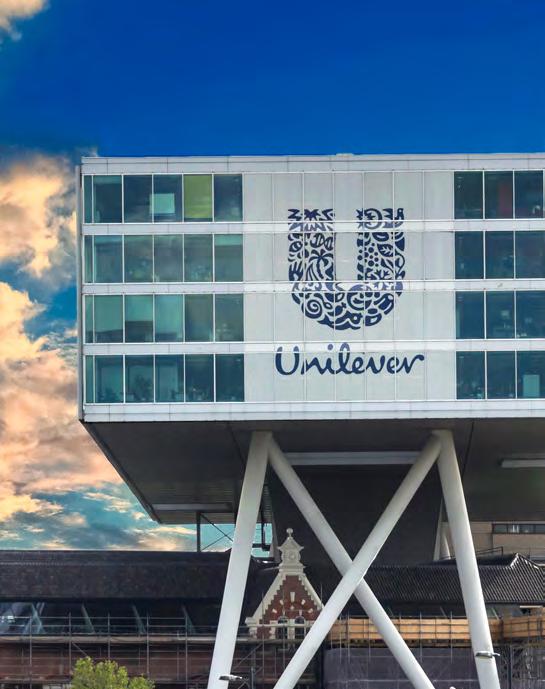
Hopefully, you will come away from this feature with a deeper understanding of what drives the consumer giant’s performance and a fair chance of sizing up whether that will continue in the future.
STEP 1 ANALYSING SALES GROWTH
Let’s start by looking at revenue growth over the last decade. The first thing to note about Unilever is it isn’t a single business, it is a collection of five separate units each serving different consumer markets: home care, personal care, beauty and wellbeing, nutrition and ice cream.
The table overleaf shows how Unilever’s sales have grown over the last decade...
A second point to make is that the group has changed a lot over the last decade as businesses have been bought and sold, and the rate of inflation – which dictates how much the firm can raise prices – has also changed over the last decade, especially in the last two years.
Pricing power is crucial for a company like Unilever because sales growth factors in the volume of sales for each product line and the average selling price.
As a rule of thumb, the more a company raises its prices the bigger the negative effect on volumes as customers look for alternatives – only firms with strong brands can raise prices without hurting unit sales.
Another important factor for Unilever is the

Feature: Unilever 10 August 2023 | SHARES | 25
Unilever (p) 20142016201820202022 2,000 2,500 3,000 3,500 4,000 4,500 5,000 Chart: Shares magazine•Source: Refinitiv
Sales growth and price/volume mix
Sales growth and price/volume mix
Sales €bn Change
Underlying sales growth
Note: 2017 sales, LFL growth, operating profit, operating margin and free-cash-flow figures all exclude the spreads business which was held for sale. Underlying sales growth reference to the increase in sales, excluding any change from acquisitions, disposals, currencies and price growth in excess of 26% in hyperinflationary economies.
Note: 2017 sales, LFL growth, operating profit, operating margin and free-cash-flow figures all exclude the spreads business which was held for sale. Underlying sales growth reference to the increase in sales, excluding any change from acquisitions, disposals, currencies and price growth in excess of 26% in hyperinflationary economies.
Table: Shares magazine • Source: Unilever annual reports
Table: Shares magazine • Source: Unilever annual reports
performance of the euro, the firm’s chosen reporting currency, against other major currencies, in particular the dollar as the firm has a large exposure to both the US and emerging markets, where local currencies are often pegged to the greenback.
As the chart shows, in aggregate Unilever’s sales were barely changed from 2013 to 2019, then they dropped due to the pandemic, although it could be argued volume growth held up reasonably well in 2020 and 2021.
The step change came last year when the firm ratcheted prices up by over 11% to cover rising input costs, sending sales up over 14% to more than €60 billion.
Even including this outstanding result, however, we calculate Unilever has only grown its sales at an average annual rate of 2% over the last decade which is disappointing given its portfolio includes 14 ‘billion-euro’ brands.
The company has faced criticism over its sprawling structure from major shareholders including Fundsmith Equity (B41YBW7) and US manager AllianceBernstein, which called for a ‘root and branch’ restructuring, and just over
a year ago US activist Nelson Peltz – who has previously targeted Unilever’s rival Procter & Gamble (PG:NYSE) and food group Kraft Heinz (KHC:NASDAQ) – joined the board after taking a stake in order to ‘help drive strategy, operations and shareholder value for the benefit of all stakeholders’.
Jefferies analyst Martin Deboo has suggested ‘the right path to unlock value at Unilever’ is via disposals from its slow-growing foods business or a complete separation of the unit through a sale or spin-off, but for now the company is resisting.
STEP 2 HOW PROFITABLE ARE SALES?
Given how slowly Unilever tends to grow its revenue – and assuming it doesn’t repeat 2022’s double-digit growth rate this year –the next question is how much profit does it make on each euro of sales?
If the company can expand its margins, then maybe a pedestrian top-line performance is acceptable – after all, if profits are rising faster than sales it must be doing something right?
Here, the picture is more encouraging with
Feature: Unilever 26 | SHARES | 10 August 2023
202260.1 14.5% 9.0% 11.3% −2.1% 2021 52.4 3.4% 4.5% 2.9% 1.6% 202050.7 −2.4% 1.9% 0.3% 1.6% 2019 52.0 2.0% 2.9% 1.6% 1.2% 201851.0 0.6% 2.9% 1.0% 2.1% 2017 50.7 2.2% 3.5% 2.4% 1.0% 201652.7 −1.0% 3.7% 2.8% 0.9% 2015 53.3 10.0% 4.1% 2.1% 1.9% 201448.4 −2.7% 2.9% 1.9% 1.0% 2013 51.3 10.5% 6.9% 3.3% 3.4% AVERAGE 2.0% 4.2% 3.0% 1.3% Year
€bn
Sales
Change Underlying sales growth Price Volume
202260.1 14.5% 9.0% 11.3% −2.1% 2021 52.4 3.4% 4.5% 2.9% 1.6% 202050.7 −2.4% 1.9% 0.3% 1.6% 2019 52.0 2.0% 2.9% 1.6% 1.2% 201851.0 0.6% 2.9% 1.0% 2.1% 2017 50.7 2.2% 3.5% 2.4% 1.0% 201652.7 −1.0% 3.7% 2.8% 0.9% 2015 53.3 10.0% 4.1% 2.1% 1.9% 201448.4 −2.7% 2.9% 1.9% 1.0% 2013 51.3 10.5% 6.9% 3.3% 3.4% AVERAGE 2.0% 4.2% 3.0% 1.3% Year
Price
Volume
Unilever becoming increasingly profitable both on an absolute basis and in terms of operating profits as a percentage of sales over the last decade, although the pandemic has clearly taken a toll.
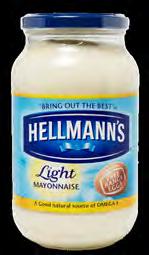
As with sales, margins in both absolute and percentage terms were on a rising path until the pandemic and even then, they held up relatively well.
However, rampant cost inflation in 2022 saw the operating margin drop back below its average despite the firm raising prices by over 11%.
The key questions for this year and next year are as follows:
● Will input costs increase at a slower pace?
● Will Unilever be able to keep its prices where they are without suffering further falls in volume?
If the answer to both is yes then margins could rebound strongly.
STEP 3 HOW MUCH PROFIT CONVERTS INTO CASH?
A key ratio many analysts use when looking at companies is cash flow conversion,
Operating margin
which measures how effectively a business turns sales into cash.
There is an old saying that cash is fact, everything else is a matter of opinion, and there have been numerous cases of companies with seemingly strong profits getting into serious difficulty because they didn’t turn enough of their sales into cash.
By measuring how much cash Unilever generates after working capital outflows for operations and maintenance spending compared to its stated net profits, we can get an idea of the underlying liquidity of the business.
With a couple of exceptions, over the last decade Unilever has managed to generate cash equivalent to around 80% to 90% of its net profits and has topped 100% of net profits on occasion.
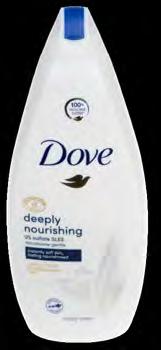
The good news for investors is that maintenance capital expenditure at Unilever is quite low compared with an industrial company, for example, which has to continually invest in plant and equipment to stay competitive. Although as a maker of fast-moving consumergoods, advertising is a major cost for Unilever if its brands are to stay
Free cash flow ratio
Operating margin
Feature: Unilever 10 August 2023 | SHARES | 27
8.3 5.2 62.7% 6.6 6.4 97.0% 6.1 7.7 126.2% 6.0 6.1 101.7% 9.8 5.0 51.0% 6.5 5.4 83.1% 5.5 4.8 87.3% 5.3 4.8 90.6% 5.5 3.1 56.4% 4.9 4.3 87.8% AVERAGE 84.4% Net
€bn Free cash flow €bn Ratio
Profit
9.7 1.0% 16.1% 9.6 2.9% 18.3% 9.4 −5.8% 18.5% 9.9 5.3% 19.1% 9.4 5.6% 18.4% 8.9 10.4% 17.5% 8.1 2.5% 15.3% 7.9 −1.2% 14.8% 8.0 14.3% 16.5% 7.0 9.4% 13.8% AVERAGE 3.2% 16.8% Operating profit €bn Change Margin
Table:
Shares magazine • Source: Unilever annual reports
9.7 1.0% 16.1% 9.6 2.9% 18.3% 9.4 −5.8% 18.5% 9.9 5.3% 19.1% 9.4 5.6% 18.4% 8.9 10.4% 17.5% 8.1 2.5% 15.3% 7.9 −1.2% 14.8% 8.0 14.3% 16.5% 7.0 9.4% 13.8% AVERAGE 3.2% 16.8% Operating profit €bn Change Margin
Table: Shares magazine
•
Source: Unilever annual reports
R&D, brand and marketing expenses (€m)
relevant and at least maintain their market share.
If, as seems likely, input cost inflation slows or even turns negative during the course of 2023 and 2024, then free cash flow as a ratio of net profits should rise sharply in line with the operating margin.
STEP 4 ALLOCATION OF CAPITAL
Having looked at how much cash the firm generates, what does it do with it?
Capital allocation is a huge bugbear for Unilever’s critics, who complain the firm frequently invests in businesses which add little to no value and should instead return surplus cash to shareholders.
The acquisition of start-up Dollar Shave Club in 2016 is a case in point – Unilever paid $1 billion for the ‘disruptor’, or five times that year’s expected sales, more on the strength of its connection with millennial male customers than the quality of its product offering or its capital returns.
In its fourth-quarter results last year, Unilever admitted that while it was ‘marginally profitable’,
Dollar Shave Club’s sales had ‘continued to decline in a fiercely competitive market’ and the business had not lived up to expectations, resulting in a large write-down.
Another good example – in this case a nearmiss – was the company’s failed £50 billion bid in early 2022 for GSK (GSK) and Pfizer’s (PFE:NYSE) jointly-owned consumer health unit now known as Haleon (HLN), a deal described by Fundsmith Equity (B41YBW7) founder and manager Terry Smith as a ‘near-death experience’.
Smith insists the companies he invests in should allocate ‘his’ capital to projects which will generate the highest return, and he measures a management team’s ability to add value by looking at the return on capital employed, also known as ROCE.
On this count, Unilever could do much better – we found the last five years’ worth of return on capital employed on Morningstar’s website, and scanning through earlier annual reports there is not
Feature: Unilever 28 | SHARES | 10 August 2023
2022 908 1.5 7,821 13.0 2021 847 1.6 6,873 13.1 2020 800 1.6 7,091 14.0 2019 840 1.6 7,272 14.0 2018 900 1.8 7,150 14.0 2017 900 1.7 7,575 14.1 2016 978 1.9 7,731 14.7 2015 1,005 1.9 8,003 15.0 2014 955 2.0 7,166 14.8 2013 1,040 2.1 7,383 14.8 Year R&D
% of Sales Marketing Marketing
% of Sales
R&D as
as
R&D = Research and development Table: Shares magazine • Source: Unilever annual reports
Unilever price to earnings ratio - history
Unilever price to earnings ratio - history
As to the investment case, we can certainly envisage a scenario where, if input costs fall – or at least rise at a much slower pace than they have over the past year – and the firm can make its price rises stick then margins, cash flow and earnings should all rebound even without a big increase in sales volumes.

Unilever said in first-half results on 25 July that it had absorbed most of the increase in input costs. It commented: ‘Our expectation for net material inflation for 2023 is around €2 billion of which €0.4 billion is anticipated in the second half. We continue to expect a modest improvement in underlying operating margin for the full year, reflecting higher gross margin and increased investment behind our brands.’
even a mention of return on capital.
The company prefers to look at return on assets which ‘provides additional insight on the performance of the categories and assists in formulating long-term strategies with respect to allocation of capital,’ according to the company.
For our part, we would suggest the firm publishes its ROCE in future as for many investors –actual and potential – it is a crucial benchmark.
STEP 5 VALUATION AND INVESTMENT CASE
Judging by the sideways performance of its shares this year, the jury would seem to be out on whether Unilever is a buy or not.
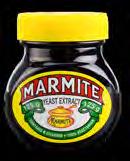

On a 12-month forward price to earnings metric, the stock trades at 18.4-times which is towards the low end of its range over the last decade, while on a ratio of EV (enterprise value) to EBITDA (earnings before interest, taxes, depreciation and amortisation), which includes debt as well as equity in the calculation, it trades on just over 12-times which again is at the low end of its historic range.
Return on capital employed
Meanwhile, the arrival of a renowned activist on the board and the oversight of big institutional investors might at last stop the firm spending its increased cash flow on acquisitions of dubious worth and encourage it to think instead about ways of improving shareholder returns.
When you weigh up the different factors, we rate the shares as a ‘buy’.
12 month forward EV/EBITDA - history
By Ian Conway Companies Editor
Feature: Unilever 10 August 2023 | SHARES | 29
2022 2021 2020 2019 2018 21.2% 18.0% 18.5% 20.7% 32.0% Chart: Shares magazine•Source: Morningstar, Unilever annual reports Return
2022 2021 2020 2019 2018 21.2% 18.0% 18.5% 20.7% 32.0% Chart: Shares magazine•Source: Morningstar, Unilever annual reports Unilever
20142016201820202022 11 12 13 14 15 Chart: Shares magazine•Source: Refinitiv
on capital employed
DISCLAIMER: The author of this article (Ian Conway) and the editor (Daniel Coatsworth) own units in Fundsmith Equity.
20142016201820202022 16 18 20 22 24 26 Chart: Shares magazine•Source: Refinitiv
20142016201820202022 16 18 20 22 24 26 Chart: Shares magazine•Source: Refinitiv
The US economy has kept powering ahead but can it continue?
Transport stocks and indices are providing mixed signals

Regular readers of this column will know (or even bewail) its status as a bit of a trainspotter, quite literally when it comes to transport stocks. Owners of planes, ships, trucks and trains are right at the front line of the economy, because when things are going well their services are in demand, as goods must be shipped, and inventory replenished and also because the opposite holds true when things are going badly.
This is particularly important now, since equity markets seem convinced there will be no economic landing (not even a soft one, let alone a hard one), and government bond markets also appear to be pricing in sustained inflation and, by implication, higher nominal growth.
At least, that seems to be a logical inference to draw from how both America’s S&P 500 equity benchmark and the yield on 10-year US treasuries are barrelling higher.
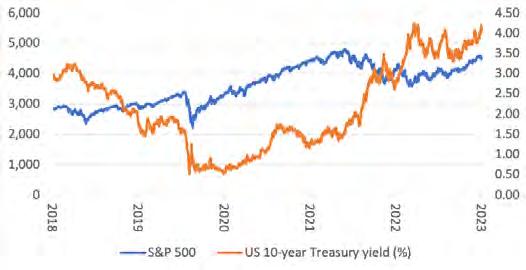
US stock and bond markets look to be pricing in higher (nominal) economic growth
as exports fell 14.5% year-on-year and imports by 12.4% in July. These can be partly explained away by the impact of American (and global) sanctions and tariffs on key industries, but the world’s second-largest economy is hardly flying, if these numbers are a dependable guide.
The new chief executive of AP Møller-Maersk (MAERSK-B:CPH), the world’s largest operator of container ships, has just cut the company’s forecast for global demand to a drop of 1% to 4% in 2023, compared to 2022. While investors could be forgiven for ignoring the views of one Danish firm, it might be unwise to do so. Until the past year or so, its shares have been a fair guide to the trajectory of the FTSE All-World index.


Global stocks are rising even as shares in vital container shipper sink

Source: Refinitiv
LAND OF THE FREE
Source: Refinitiv
But the picture may not be quite so simple. The latest monthly trade figures from China were awful,
The key words there may be ‘until the past year or so’. AP Møller-Maersk’s may be sinking to levels last seen almost three years ago, when the pandemic was still rife, but the FTSE All-World index is buoyant and the reason for this apparent parting of the ways may take us back to our starting
Russ Mould: Insightful commentary on market issues 30 | SHARES | 10 August 2023
point – America.
This is because the US stock market represents around two-thirds of global market capitalisation, so it can be argued that the world will follow wherever America goes. This may be good news for investors with hefty equity exposure, if the S&P 500 and US treasuries are right and nominal economic growth is going to keep on proving stronger, and inflation more persistent, than markets expect. It may be less good for bond holdings, however.
A further reliable yardstick also suggests the US economy could keep on powering ahead. The Dow Jones Transportation index, a 20-stock of aviation, trucking, shipping and rail specialists, is closing back in on 2021’s all-time high. Dow Theory, as developed by Robert Rhea way back in the 1930s, suggests that the Industrials will follow where the Transports go.
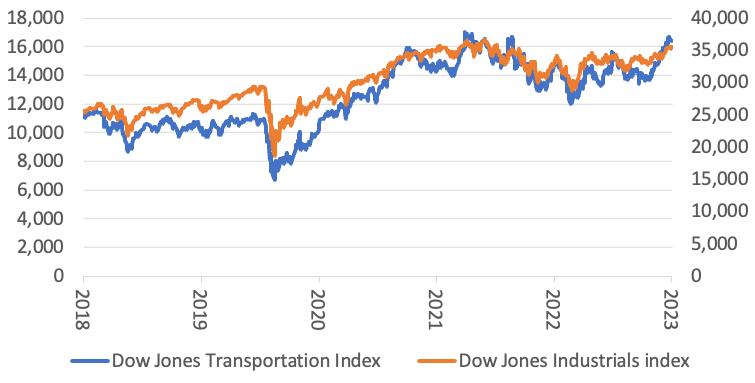
US transport stocks are tugging the industrials higher

philosophy, light-touch regulation and the deep pools of capital which support innovation without fear of, or any stigma attached to, failure.
Others will look for more a tangible explanation in the form of Bidenomics, a concept that seems to rely more heavily upon state intervention and support. The Inflation Reduction Act and the Creating Helpful Incentives to Produce Semiconductors (CHIPS) Act of 2022 pumped over $1 trillion into the US economy and boosted many sectors in the process, including engineering and construction, as the White House pushed to onshore production and enhance its national capabilities in key industries ranging from silicon chips to renewable energy.
The benefits to US economic growth and corporate earnings seem clear, but there is one potential snag. The Biden presidency’s policies mean US government spending is surging even as tax receipts weaken (itself perhaps a sign that the underlying economy is not quite as strong as equity markets like to think). The US budget deficit for the fiscal year to September 2023 already exceeds that for 2022, with data for the final three months yet to come.
Source: Refinitiv
TAX AND SPEND
However, all of this begs the question of why the US economy continues to power along when so many others are plodding, including China. Supporters will lean toward the concept of American exceptionalism, its free-market
As Fitch’s downgrade of America’s credit rating to AA+ from AAA in July makes clear, this is not sustainable. The IRA and CHIPS Acts must generate a return, or there could be trouble ahead on more than one level, although the chances of President Biden turning off the spending taps ahead of the November 2024 election are presumably slim.
By Russ Mould Investment Director at AJ Bell

Russ Mould: Insightful commentary on market issues 10 August 2023 | SHARES | 31
How packaging companies are positioned for the shift away from plastic

We look at the potential market and run the slide rule over the players
If we think about what packaging companies do, probably the first thing that comes to mind for most of us is getting a brown cardboard box or envelope through the post from Amazon (AMZN:NASDAQ) with its tell-tale smiley logo.
Yet e-commerce is just a small part of the overall business of firms like DS Smith (SMDS), Mondi (MNDI) and Smurfit Kappa (SKG), who together dominate the European market for card and cardboard.
Packaging for food and other fast-moving consumer goods makes up around 75% of sales for the industry on average, and for some firms the mix is even higher.
The company claims packaging ‘is at the top of customers’ priorities for a reason’ – namely that it accounts for 70% of the UK’s plastic waste – and it has removed nearly 2.2 billion pieces of plastic from its business.
Multipacks of tins and bottles are no longer wrapped in plastic but in cardboard, and Tesco has sent all its suppliers a green list of nine easy-torecycle materials which it encourages them to use for packaging while pressing them to stop using PVC, waxed or siliconised paper, polystyrene, MDF and other non-recyclable materials.
The trickiest area to use cardboard instead of plastic is in fresh food, but even here supermarkets are learning new tricks with salads and fresh vegetables now available in brown cardboard pots or breathable containers.
PASSING THE ‘PAPER STRAW TEST’
So, what can be done about replacing the amount of plastic used in food and drink packaging for instance? And which companies stand to benefit from this trend?

SUPERMARKETS TAKING THE LEAD
As part of its push for sustainability, the UK’s biggest grocery chain Tesco (TSCO) uses what it calls ‘The Four Rs’ – Remove, Reduce, Reuse and Recycle – to cut its use of plastic packaging.
It removes plastic where it can, reduces it where it can’t, reuses a growing proportion and recycles what’s left.
Kira Bindrim, editor of Bloomberg’s Greener Living newsletter, says consumers are generally happy to try new ways of shopping and living greener, even if it costs a few pence extra.
‘If you ask people whether they’re willing to change their buying habits in the interest of helping the planet, most of them will say yes; many will even say they’d spend more money to do it.
‘In practice, though, it really helps if a sustainable solution also costs less, is more convenient or is simply cool to adopt. Fortunately, more products in more places are moving in that direction.
‘There’s a common misconception that changing how you live in the interest of the climate is
Feature: Packaging companies 32 | SHARES | 10 August 2023
synonymous with sacrifice. That decarbonising always means downgrading. I call this the Paper Straw Conundrum, because few products do more than paper straws to convince people sustainability means embracing solutions that suck.’
DS Smith, which makes 86% of its sales to the fast-moving consumer goods industry, has long been at the forefront of using cardboard instead of plastic, from its trays and shelf-ready packaging solutions to point-of-sale display stands.
The firm estimates over 70% of shoppers’ decisions are made after customers have entered the store, and in a highly competitive environment like food retail, packaging has to make the product look attractive as well as functioning properly.
Its Ecovete cardboard punnets replace plastic trays for fruit and vegetables, while its Eco Bowl for fresh, chilled or frozen meat and fish lowers the use of plastic by 85% without reducing shelf life and is easily recyclable.
In the last year, DS Smith has helped its customers replace 300 million pieces of plastic packaging with fibre-based alternatives, and by 2025 it aims to have removed 1 billion pieces of ‘problem’ plastic from supermarket shelves.
Its in-house team of 700 designers has already created over 1,000 new designs for millions of products, allowing customers to take plastic out of the packaging process.
HOW BIG IS THE MARKET?
According to the OECD (Organisation for Economic Cooperation and Development), even if the amount of plastic that is recycled doubles between now and 2060, the amount of plastic waste produced globally is on track to almost triple, with around half ending up in landfill, a third being incinerated and less than a fifth being recycled, as the global population and incomes increase.
Two-thirds of that waste is expected to come from short-lived items like packaging, low-cost products and textiles. Despite developing and emerging economies growing faster, developed countries will still produce much more plastic waste per person (238kg per year, on average) than developing countries (77kg per person, per year).
Today, the amount of plastic waste being created each year weighs around 300 million tons, or the same as the entire human population, and half of that total is single-use plastic which is thrown away
the minute it has been used.
The OECD suggests there should be taxes on plastics, including packaging, targets for recycled content in new plastic products, increased litter collection and improved waste management infrastructure.
Yet even a small change, like swapping plastic sealing tape with self-locking tabs or printing directly onto cardboard rather than using plastic labels, could make a big difference if it were scaled up.
WHAT IS AMAZON DOING?
The world’s largest retailer knows its customers want their orders delivered in right-sized, easily recyclable packaging that ensures the product arrives undamaged and with minimal impact on the environment.

Amazon says it has eliminated the use of more than 1.5 million tons of materials since 2015 despite the number of shipments having grown significantly.
It has already moved away from plastic packaging in most of its major markets including Europe, India, Japan and Australia, with the volume of single-use plastic used across its global operations network (i.e., orders shipped through its own fulfilment centres) down 11% last year from around 97,000 tons to less than 86,000 tons.
It has also reduced its use of corrugated boxes by over 35% in North America and Europe over the last five years by switching where possible to padded mailers and bags which are up to 75% lighter.
Last month it made a further commitment to reduce plastic use in the US by phasing out its ubiquitous blue and white and other plastic mailers which are not accepted by most curb side recycling collections in favour of alternative solutions including lightweight paper-padded mailers.
Feature: Packaging companies 10 August 2023 | SHARES | 33
That decision will significantly reduce the company’s plastic footprint, given that pouches and bags represent over 30% of e-commerce plastic packaging globally.
ARE SHARES IN PACKAGING COMPANIES WORTH BUYING?

The valuations of DS Smith and Mondi have come down a long way in the last five years, with both stocks trading well below their mid-2018 highs and their (pre-pandemic) February 2020 levels, while Smurfit Kappa has led more of a charmed life, only peaking in 2021 and still well above its prepandemic value.
The analysts expect consensus earnings estimates to rise, helped by lower energy and raw material costs, leading to a re-rating in the second half of this year.
Smurfit Kappa reported first-half earnings on 2 August, with EBITDA (earnings before interest, tax, depreciation and amortisation) of €1.1 billion, down 5% on last year, due to a 6% fall in box volumes.
Analysts at US investment bank Morgan Stanley concur that earnings across the sector are likely to be lower in the first half, but argue much is already priced in and, with the margin cycle now at the bottom, this is the time to invest.
The team’s pick is Mondi, which described its half-year results on 3 August as ‘delivering in challenging markets’. The company said: ‘Whilst underlying EBITDA was lower, the business exhibited its strong cash generative characteristics, improving cash generation.
Fears of profit warnings due to high energy costs following the invasion of Ukraine, soaring interest rates and destocking by customers in anticipation of lower prices to come, have seen shares in DS Smith and Mondi de-rated to the point where their current valuations are between 20% and 25% below their mid-cycle average according to analysts at broking firm Davy.
‘With destocking easing, European box demand has troughed,’ they argue, while ‘progressively easing second-half 2023 comparators provide a path to 2024 packaging demand growth’.
‘So far in 2023, demand and prices have declined sequentially with the exception of containerboard prices which stabilised in the later part of the half year. We saw some benefit from lower input costs which continue to ease as we progress into the third quarter of the year.
‘We remain focused on improving productivity and efficiency, while expanding capacity in our growing packaging segments. We have a compelling portfolio of sustainable packaging and paper products, scale and a resilient business model, which position us well to deliver attractive returns and sustainable value accretive growth.’
DS Smith isn’t due to update the market until its first quarter results at the beginning of September, but the team at Davy see pricing staying ‘resilient’
Feature: Packaging companies 34 | SHARES | 10 August 2023
DS Smith (p) 20192020202120222023 200 300 400 500 Chart: Shares magazine•Source: Refinitiv Mondi (p) 20192020202120222023 1,500 2,000 Chart: Shares magazine•Source: Refinitiv
in spite of lower volume demand while lower costs feed through into higher margins.
In its full-year results in June, the firm demonstrated strong pricing power, lifting its operating profit by 40% to £861 million and showing that meeting customer demand for more sustainable products can also improve margins.

Clive Beagles, manager of the Equity Income Fund (B03KR61) of DS Smith. Speaking to Shares ‘People were concerned about a destocking phase in the packaging industry after paper prices went up because of higher energy prices following the Ukraine war, and they are now coming down

because customers think prices will fall.
‘In fairness, volumes have been a little bit softer but it feels to us as if that destocking phase is pretty much done. It’s been going on for six to nine months, which is about the right duration.
‘The thing that excites us is the opportunity for volume growth to come from the switch away from plastic towards cardboard in food packaging. The vast majority of fresh food in supermarkets is wrapped in plastic, but the coatings that cardboard bring are getting better and better, and in time I suspect meat and fish will be predominantly cardboard-packed.
‘We think food packaging can add 1% to 1.5% to annual volume growth in an industry that isn’t particularly high-volume growth and tends to ebb and flow along with GDP. That tailwind could easily

Feature: Packaging companies 10 August 2023 | SHARES | 35
Events TITLE Type of event Date Link to register www.sharesoc.org WARPAINT LONDON (W7L) Company Webinar 27 Sep 2023 Click here to register CENTRALNIC (CNIC.L) Company Webinar 06 Sep 2023 Click here to register Follow us on CENTRALNIC AFTER-MEETING SIGnet After-meeting 06 Sep 2023 Click here to register SUPERMARKET INCOME REIT (SUPR) Company Webinar 11 Oct 2023 Click here to register
What are the tax implications of having a side hustle like selling on Ebay or Etsy?
It is possible to have multiple sources of income and still qualify for certain tax allowances
Lots of people are trying to generate more money and alternative incomes during the cost-of-living crisis, but they need to make sure they are up to date on the tax rules around earning extra money to avoid the taxman asking for unpaid dues.
More than one in three adults has more than one income stream, according to Utility Warehouse, as people look to take on more jobs or turn a hobby into a money-making venture. The organisation found that people made on average £780 a month through these side hustles.

But whether you’re earning money on the side just to boost your income or you plan for it to become your main job, make sure you’re paying the right tax on the money now to avoid a nasty surprise from the taxman later on.
WHAT ARE YOUR TAX-FREE LIMITS?
Everyone gets a personal allowance of £12,570, which is the amount of money they can earn in a year before they start to pay income tax.
If you earn less than this amount through all your income then you’ll pay no income tax on it. Lots of people with an employed job will use up this tax-free allowance from their main employment, but if you earn less than this you can use the remainder for your side hustle earnings.
There is also a trading allowance, which means you can earn £1,000 a year from property or trading income tax free. This is great for people doing a bit of work on the side, for example babysitting or selling items on an online marketplace. The good news is that if you earn less than £1,000 a year from your side hustle then you won’t usually need to fill out a tax return, but check out any exemptions here. Just make sure you keep track of any relevant paperwork proving your income in case HMRC asks for it later.
If you earn more than £1,000 from your side hustle in a tax year, you’ll still benefit from the tax break but you’ll need to fill out a tax return to declare the extra income and pay any relevant tax. Also, if you’re earning more than £1,000 and are buying and selling stock HMRC will deem that a
Personal Finance: Paying tax on side hustle earnings 36 | SHARES | 10 August 2023
business, which means you need to register it as a company or register as a sole trader.
If you’re registered as a sole trader or company, you’ll have the choice of whether you claim the £1,000 trading allowance or whether you forego that and instead deduct expenses from your gross income and pay tax on the rest. It will depend on your circumstances which is most tax efficient.
WHAT ABOUT FOR RENTING OUT PROPERTY?
The Government also gives a tax break for anyone who rents a room out in their home. Lots of homeowners are looking at doing this activity to generate extra money and counteract the rising cost of mortgages. You can make up to £7,500 a year tax free through rent-a-room relief.
You must be renting out a room in your home, rather than a separate flat, and the room must be furnished. But it’s not limited to a room, you can rent out as much of your home as you like.

You can also use it if you run a bed and breakfast or guest house, so long as it’s in the same property you live in. Interestingly you don’t even need to own the home to benefit, you could be renting out part of your rental property – however you’ll need to check that your lease doesn’t prohibit that activity.
You don’t have to let the room for a minimum period of time. But be aware that if you jointly own the property with someone and split the income you only get half the relief per person. If you earn less than £7,500 a year you won’t need to fill in a tax return, but if you earn more than the tax-free limit you will.
WHAT ABOUT A SECOND JOB?
If you take on a second job, you’ll just need to fill out the usual new-starter paperwork with your employer and if you’re paid through PAYE, you’ll pay any tax you owe through your pay, as usual. It means you won’t need to fill out a self-assessment tax return unless you need to for another reason.
It’s worth checking that your current employer doesn’t have any rules around taking on an extra job or working more hours. One thing to consider is that your additional income might mean you hit certain tax thresholds – it might push you into the higher-rate income tax bracket, for example, or mean you hit the taper point for child benefit. So just bear that in mind and factor it in.
By Laura Suter AJ Bell Head of Personal Finance


Personal Finance: Paying tax on side hustle earnings 10 August 2023 | SHARES | 37
13 SEPTEMBER 2023
NOVOTEL TOWER BRIDGE

LONDON EC3N 2NR
Registration and coffee: 17.15
Presentations: 18.00
During the event and afterwards over drinks, investors will have the chance to:
• Discover new investment opportunities

• Get to know the companies better
• Talk with the company directors and other investors
Sponsored by
COMPANIES PRESENTING
CADENCE MINERALS (KDNC)

Cadence is dedicated to smart investments for a greener world. The planet needs rechargeable batteries on a global scale – upcoming supersized passenger vehicles, lorries and buses – require lithium and other technology minerals to power their cells. Cadence is helping find these minerals in new places and extracting them in new ways. With over £20 million vested in key assets globally.
OROCO RESOURCE CORP (TSX-V:OCO.V)
The Santo Tomas deposit is an emerging copper giant, with a multi-million tonne resource demonstrated by historical exploration. Following an extensive ongoing exploration drill program, that is both confirming and expanding the historical findings. This is an opportunity to participate in a significant copper resource development at a time of dramatically rising copper demand and increasing acquisitive interest by major mining companies.
Reserve your place now!
Register for free now www.sharesmagazine.co.uk/events
LIVE EVENT
Our reader also wants to know the rules around beneficiaries inheriting a pension

I have a self-invested personal pension (SIPP) which is entirely invested in cash and which will transfer to my wife on my passing. My wife also has a SIPP invested 100% in cash.
If a future government reintroduces the lifetime allowance, will any pension my wife inherits from me count towards her lifetime allowance? And assuming my wife passes away after me, can her SIPP be passed to our daughter and further down the generations?
Anonymous
A SIPP is a flexible type of pension that allows you to invest in a broad range of assets and usually offers complete flexibility over how you access your fund.
There are a wide range of SIPP providers offering different levels of service and, crucially, charging different prices for administering your fund.
Choosing a low-cost pension that provides the level of choice, flexibility and service you need is crucial to ensuring you are able to make the most of your retirement pot.

It’s also worth touching on your pension investments. Generally speaking, most people investing via a SIPP will be taking at least some investment risk, in line with their risk appetite and with the aim of delivering long-term returns.
When investing for the long-term there are no guarantees and the value of your fund can go down as well as up, particularly in the shortterm. Investing 100% of your pension in cash will leave your fund open to the ravages of inflation, particularly if you maintain this approach for a long period of time.
An exception is when someone is planning to access their entire pension in the near future or buy an annuity. Anyone considering the former should think carefully about the consequences of withdrawing their entire retirement pot in one go, in particular the tax implications and how they plan to fund their retirement.
Ask Tom: Your retirement questions answered 10 August 2023 | SHARES | 39
Tom Selby, AJ Bell Head of Retirement Policy, says:
The lifetime allowance is being abolished but what if a future government reintroduces it?
WHAT ABOUT THE LIFETIME ALLOWANCE?
The lifetime allowance was designed to limit the amount of pension you could build up tax-free over your lifetime before being hit with a tax charge. In his March 2023 Budget, chancellor Jeremy Hunt announced his intention to abolish the lifetime allowance from April 2024. In the meantime, the lifetime allowance tax charge has been removed.
One of the attractions of defined contribution pensions like SIPPs is they can be passed on taxefficiently to your nominated beneficiaries – and potentially completely tax-free. They should not normally be included in your estate for inheritance tax purposes.

This does not mean that inherited defined contribution pensions will always be completely tax-free. The tax treatment depends on how old you are when you die – and this is where it gets a bit complicated, so bear with me.
WHAT HAPPENS WHEN SOMEONE INHERITS A PENSION?
There are two ways your beneficiaries can access an inherited pension – as a lump sum or as income. Tax treatment on death also depends on whether you die before your 75th birthday.
In 2023/24, if you die before age 75, it is possible to inherit any pension taken as a lump sum or as income completely tax-free. This is the case regardless of whether or not your pension has already been accessed (or ‘crystallised’ in the jargon).
However, be aware that any funds passed on from a pension that has not yet been accessed will be checked against the lifetime allowance, which for most people is £1,073,100. If you have used up your lifetime allowance, income tax will be charged on the excess if it is taken as a lump sum.
If you die after age 75 in 2023/24, things are a bit simpler – income tax will be applied to the entire pension, whether it’s inherited as a lump sum or as income.
By taking any inherited pension as income, your beneficiary (or beneficiaries) can minimise their income tax bill by drip-feeding withdrawals.
The person who inherits your pension can, in turn, pass any unused funds on to their nominated beneficiaries when they die. This means pensions can be used to cascade wealth tax-efficiently down the generations.
WHAT HAPPENS WHEN THE LIFETIME ALLOWANCE IS ABOLISHED?
From 6 April 2024 onwards, the government has confirmed the lifetime allowance will be abolished completely. In its place, it has proposed introducing two new limits:
• A ‘Lump Sum Allowance’ set at £268,275
• A ‘Lump Sum and Death Benefits Allowance’ set at £1,073,100
There is still some uncertainty over exactly how this new regime will operate. Once we have clarity on this, I’ll happily return to it in a future column.
With regards to your question about a future government reintroducing the lifetime allowance, at this stage we have no idea if this will happen, how it would be done or who would be affected. It is therefore best to deal with the tax rules as you see them, rather than trying to second-guess what may or may not happen in the future.
DO YOU HAVE A QUESTION ON RETIREMENT ISSUES?
Send an email to asktom@sharesmagazine.co.uk with the words ‘Retirement question’ in the subject line. We’ll do our best to respond in a future edition of Shares
Please note, we only provide information and we do not provide financial advice. If you’re unsure please consult a suitably qualified financial adviser. We cannot comment on individual investment portfolios.
Ask Tom: Your retirement questions answered 40 | SHARES | 10 August 2023
WATCH RECENT PRESENTATIONS

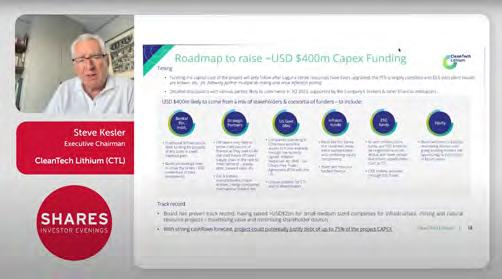
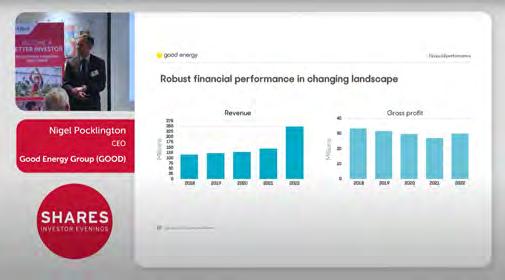

CleanTech Lithium (CTL)
Aldo Boitano, CEO & Steve Kesler, Executive Chairman
CleanTech Lithium is proudly sustainable and committed to net-zero. Our mission is to produce carbon-neutral lithium for the Electric Vehicle (EV) future. With proven sustainable Direct Lithium Extraction technology, powered by clean energy, we plan to be the leading supplier of green lithium to the EV market.
Hercules Site Services (HERC)
Brusk Korkmaz, CEO & Paul David
Wheatcroft, CFO



Hercules Site Services is a leading technology enabled labour supply company for the UK infrastructure sector. Hercules provides a labour-related diverse range of other services to many blue-chip clients in the infrastructure sector including Balfour Beaty, Kier and Thames Water.
Good Energy Group (GOOD)
Nigel Pocklington, CEO
Good Energy Group is a supplier of 100% renewable power and an innovator in energy services. It has long term power purchase agreements with a community of 1,700 independent UK generators. Its mission: to power a cleaner, greener world and make it simple to generate, share, store, use and travel by clean power. Its ambition: to support one million homes and businesses to cut carbon from their energy and transport used by 2025.
Visit the Shares website for the latest company presentations, market commentary, fund manager interviews and explore our extensive video archive.
CLICK TO PLAY EACH VIDEO SPOTLIGHT WEBINAR www.sharesmagazine.co.uk/videos VIDEOS
WHO WE ARE
EDITOR: Daniel Coatsworth @Dan_Coatsworth
DEPUTY EDITOR: Tom Sieber @SharesMagTom

NEWS EDITOR: Steven Frazer @SharesMagSteve

FUNDS AND INVESTMENT
TRUSTS EDITOR: James Crux @SharesMagJames

EDUCATION EDITOR: Martin Gamble @Chilligg
COMPANIES EDITOR: Ian Conway @SharesMagIan


INVESTMENT WRITER: Sabuhi Gard @sharesmagsabuhi

CONTRIBUTORS: Danni Hewson
Laith Khalaf
Russ Mould
Tom Selby
Laura Suter
ADVERTISING Senior Sales Executive Nick Frankland 020 7378 4592 nick.frankland@sharesmagazine.co.uk




Shares magazine is published weekly every Thursday (50 times per year) by AJ Bell Media Limited, 49 Southwark Bridge Road, London, SE1 9HH. Company Registration No: 3733852.
All Shares material is copyright. Reproduction in whole or part is not permitted without written permission from the editor.

DISCLAIMER
Shares publishes information and ideas which are of interest to investors. It does not provide advice in relation to investments or any other financial matters. Comments published in Shares must not be relied upon by readers when they make their investment decisions. Investors who require advice should consult a properly qualified independent adviser. Shares, its staff and AJ Bell Media Limited do not, under any circumstances, accept liability for losses suffered by readers as a result of their investment decisions.
Members of staff of Shares may hold shares in companies mentioned in the magazine. This could create a conflict of interests. Where such a conflict exists it will be disclosed. Shares adheres to a strict code of conduct for reporters, as set out below.

1. In keeping with the existing practice, reporters who intend to write about any securities, derivatives or positions with spread betting organisations that they have an interest in should first clear their writing with the editor. If the editor agrees that the
reporter can write about the interest, it should be disclosed to readers at the end of the story. Holdings by third parties including families, trusts, selfselect pension funds, self select ISAs and PEPs and nominee accounts are included in such interests.
2. Reporters will inform the editor on any occasion that they transact shares, derivatives or spread betting positions. This will overcome situations when the interests they are considering might conflict with reports by other writers in the magazine. This notification should be confirmed by e-mail.
3. Reporters are required to hold a full personal interest register. The whereabouts of this register should be revealed to the editor.
4. A reporter should not have made a transaction of shares, derivatives or spread betting positions for 30 days before the publication of an article that mentions such interest. Reporters who have an interest in a company they have written about should not transact the shares within 30 days after the on-sale date of the magazine.
Index 42 | SHARES | 10 August 2023
Main Market Aviva 10 B&M European Value7 Breedon 12 Ceres Power 23 ConvaTec 13 Crest Nicholson 12 Currys 8 DS Smith 32 Dunelm 12 Ferrexpo 9 Future 12 Games Workshop12 Genus 13 Grafton 12 GSK 26 Haleon 26 Intermediate Capital12 Kingspan 23 Marks & Spencer 9 Mondi 32 Morgan Sindall 12 Oxford Instruments12 SIG 12 Smurfit Kappa 32 Spirax-Sarco 23 Tesco 32 Unilever 25 AIM Alfen 23 Ergomed 12 Gamma Communications 12 Overseas shares Alphabet 16 Amazon 7, 17, 32 AP Møller-Maersk30 Apple 14, 18 Applied Materials24 Carrier Global 24 Eaton Corp 24 Ford 17 General Motors 17 JS Global Lifestyle8 Kraft Heinz 26 Mercedes Benz 24 Meta Platforms 17 Microsoft 16, 25 NextEra Energy 24 Northland Power23 Nvidia 17 Pfizer 26 Procter & Gamble26 Quanta Services 24 Rivian Automotive17 SharkNinja 8 Shenzen Inovance Technology 23 Signify 23 Tesla 17 TJX Companies 11 Walmart 8 Xylem 24 Investment Trusts AEW UK REIT 7 BlackRock Throgmorton 12, 15 Impax Environmental Markets 22 Jupiter Green Investment Trust 21 Pantheon Infrastructure 22 Funds Fundsmith Equity26 JOHCM UK Equity Income Fund 35 JPM Climate Change Solutions Fund 22 M&G Climate Solutions22 M&G Climate Solutions Fund 23 Pictet Global Environmental Opportunities 24 ETFs JPMorgan Climate Change Solutons 22 Lyxor Green Bond ETF22


























































































